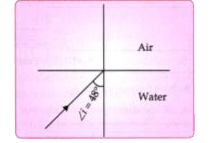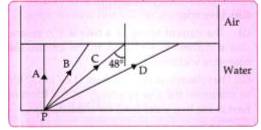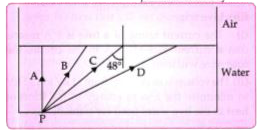Complete Solutions to SECTION-II of chapter SAMPLE PAPER 2017 of Class 10 book with complete answers and questions
| Class 10 | PHYSICS |
| Chapter | SAMPLE PAPER 2017 |
| GURUKUL | SECTION-II |
| Number Of Questions | 28 |
| Academic Year | 2023-24 |
A uniform half metre rule balances horizontally on a knife edge at 29 cm mark when a weight of 20 gf is suspended from one end.
Draw a diagram of the arrangement.02:02View SolutionA uniform half metre rule balances horizontally on a knife edge at 29 cm mark when a weight of 20 gf is suspended from one end.
What is the weight of the half metre rule ?02:31View SolutionA boy uses a single fixed pulley to lift a load of 50 kgf to some height. Another boy uses a single movable pulley to lift the same load to the same height. Compare the effort applied by them. Give a reason to support your answer.
02:14View SolutionHow does uniform circular motion differ from uniform linear motion ?
01:33View SolutionName the process used for producing electricity using nuclear energy.
01:07View SolutionA pulley system with V.R. = 4 is used to lift a load of 175 kgf through a vertical height of 15 m. The effort required is 50 kgf in the downward direction. `(g=10Nkg^(-1))`
Calculate :
Distance moved by the effort.02:02View SolutionA pulley system with V.R. = 4 is used to lift a load of 175 kgf through a vertical height of 15 m. The effort required is 50 kgf in the downward direction. `(g=10Nkg^(-1))`
Calculate :
Work done by the effort.02:38View SolutionA pulley system with V.R. = 4 is used to lift a load of 175 kgf through a vertical height of 15 m. The effort required is 50 kgf in the downward direction. `(g=10Nkg^(-1))`
Calculate :
M.A. of the pulley system.01:31View SolutionA pulley system with V.R. = 4 is used to lift a load of 175 kgf through a vertical height of 15 m. The effort required is 50 kgf in the downward direction. `(g=10Nkg^(-1))`
Calculate :
Efficiency of the pulley system.01:49View SolutionHow is the transference of heat energy by radiation prevented in a calorimeter ?
01:53View SolutionYou have a choice of three metals A, B and C, of specific heat capacities `900Jkg^(-1)""^(@)C^(-1),380Jkg^(-1)""^(@)C^(-1)and460Jkg^(-1)""^(@)C^(-1)` respectively, to make a calorimeter. Which material will you select ? Justify your answer.
01:51View SolutionCalculate the mass of ice needed to cool 150 g of water contained in a calorimeter of mass 50 g at `32^@`C such that the final temperature is `5^@`C. Specific heat capacity of calorimeter = 0.4 J `g^(-1)^@C^(-1)`, specific heat capacity of water = `4.2" J "g^(-1)""^@C^(-1)`, latent heat capacity of ice = 330 J `g^(-1)`.
06:48View SolutionName the radiations which are absorbed by the green house gases in the earth's atmosphere.
02:13View SolutionA radiation X is focused by a particular device on the bulb of a thermometer and mercury in .the thermometer shows a rapid increase. Name the radiation X.
00:36View SolutionName two factors on which the heat energy liberated by a body depends.
00:58View SolutionA lens forms an upright and diminished image of an object when the object is placed at the focal point of the given lens.
Name the lens.01:53View SolutionA lens forms an upright and diminished image of an object when the object is placed at the focal point of the given lens.
Draw a ray diagram to show the image formation.02:31View SolutionA ray of light travels from water to air as shown in the diagram given below:

Copy the diagram and complete the path of the ray. Given the critical angle for water is `48^(@)`.02:12View SolutionA ray of light travels from water to air as shown in the diagram given below:

State the condition so that total internal reflection occurs in the above diagram.02:29View SolutionThe diagram below shows a point source P inside a water container. Four rays A, B, C, D starting from the source P are shown up to the water surface.

Show in the diagram the path of these rays after striking the water surface. The critical angle for water air surface is `48^(@)`.02:45View SolutionThe diagram below shows a point source P inside a water container. Four rays A, B, C, D starting from the source P are shown up to the water surface.

Name the phenomenon which the rays B and D exhibit.01:34View SolutionState two physical factors which determine loudness of sound.
02:46View SolutionName the factor that determines :
Quality of the note.01:04View SolutionName the factor that determines :
Pitch of the note.01:36View SolutionWhat are damped vibrations ?
00:55View SolutionGive examples of damped oscillation.
03:08View SolutionName the phenomenon that cause a loud sound when the stem of a vibration tuning fork is kept pressed on the surface of a table.
00:34View SolutionA certain sound has a frequency of 256 hertz and a wavelength of 1.3 m.
(a) Calculate the speed with which this sound travels.
(b)What difference would be felt by a listener between the above sound and another sound travelling at the same speed, but of wavelength 2.6 m?02:22View Solution
SECTION-II questions and complete solutions for chapter SAMPLE PAPER 2017 of SELINA PHYSICS (ENGLISH) of Class 10
